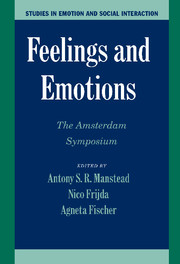Book contents
- Frontmatter
- Contents
- List of Contributors
- 1 Introduction
- PART I THE NATURE OF FEELINGS AND EMOTIONS
- PART II BASIC PSYCHOLOGICAL PROCESSES IN FEELINGS AND EMOTIONS
- PART III FEELINGS AND EMOTIONS: THE PLACE OF PLEASURE
- PART IV FEELINGS AND EMOTIONS IN THEIR SOCIOCULTURAL CONTEXT
- PART V FEELINGS, EMOTIONS, AND MORALITY
- 22 On the Possibility of Animal Empathy
- 23 Emotional Gifts and “You First” Micropolitics
- 24 Introducing Moral Emotions into Models of Rational Choice
- 25 Virtue and Emotional Demeanor
- 26 Epilogue
- Subject Index
- Author Index
- Plate section
- References
25 - Virtue and Emotional Demeanor
Published online by Cambridge University Press: 05 June 2012
- Frontmatter
- Contents
- List of Contributors
- 1 Introduction
- PART I THE NATURE OF FEELINGS AND EMOTIONS
- PART II BASIC PSYCHOLOGICAL PROCESSES IN FEELINGS AND EMOTIONS
- PART III FEELINGS AND EMOTIONS: THE PLACE OF PLEASURE
- PART IV FEELINGS AND EMOTIONS IN THEIR SOCIOCULTURAL CONTEXT
- PART V FEELINGS, EMOTIONS, AND MORALITY
- 22 On the Possibility of Animal Empathy
- 23 Emotional Gifts and “You First” Micropolitics
- 24 Introducing Moral Emotions into Models of Rational Choice
- 25 Virtue and Emotional Demeanor
- 26 Epilogue
- Subject Index
- Author Index
- Plate section
- References
Summary
The gestures which we sometimes call empty are perhaps in fact the fullest things of all.
(Erving Goffman, 1967)ABSTRACT
I argue in this chapter that emotional demeanor (especially in facial expression) is often a crucial way we show moral regard for others. I explore the extent to which such expression is subject to control and consider the problem of insincerity in posing facial expressions. For a robust discussion of these issues, I turn to Seneca's De Beneficiis (On Doing Kindnesses). Seneca's concerns in this work overlap in significant ways with those of Erving Goffman in his classic account of deference rituals.
INTRODUCTION
When we think about moral character we sometimes focus on faces and bodies. In particular, we think about emotional attitude and how it is conveyed in physical and facial comportment. So we talk about “a look of concern,” “a compassionate embrace,” “a reassuring smile,” “an empathetic tone of voice.” What is salient is emotional demeanor, or, to adapt a Kantian phrase, the “emotional aesthetic” of virtue (Kant, 1964, 405).
I emphasize “adapt,” for Kant is a controversial figure to appeal to in matters of the emotions. On an orthodox reading, his notion of an emotional “aesthetic” of virtue is meant to keep emotion at arm's length from morality, construed more narrowly in terms of willed action.
- Type
- Chapter
- Information
- Feelings and EmotionsThe Amsterdam Symposium, pp. 441 - 454Publisher: Cambridge University PressPrint publication year: 2004
References
- 1
- Cited by



